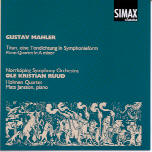Here, for the first time since Wynn Morris’ pioneering recording, is the original, five-movement tone poem version of what later became Mahler’s First Symphony. The differences between this recording and the revised version concern, of course, Mahler’s removal of the “Blumine” second movement (sometimes reinstated or performed as an appendix, at least on recordings), and many, many changes of orchestration. The details aren’t especially important, but the principles of Mahler’s later alterations are. This first edition is written for a smaller orchestra than the final version, but it sounds, paradoxically, much thicker and heavier. The reason that Mahler added to the (already substantial) quantity of brass, woodwind, and percussion on revision was to increase the music’s clarity by making the blending of instrumental colors unnecessary. In the final version, every instrument is present in sufficient numbers to either hold its own when playing a principal melodic line, or to make full, three- or four-part harmony, in both cases without further support or assistance. The result, as with all Mahler’s later work, has that peculiar combination of brilliance and transparency that makes him one of the two or three greatest orchestrators in history. Not that his first thoughts are in any way dull; it’s just that the revision is so much finer in every respect.
It may be that a better performance would make a more persuasive case for the composer’s first thoughts. Smaller orchestra or no, this is still a very large work, and the Nörrkoping Symphony Orchestra sounds distinctly understaffed in the string department right from the outset. The trumpets and horns, too, are notably less than virtuosic: the climaxes seriously lack heft. Ole Ruud’s slowish tempos in the funeral march and finale further reduce any opportunities for genuine excitement, or at least for a cumulative momentum through the second half of the work. Finally, the inclusion of a workmanlike performance of Mahler’s early piano quartet movement adds nothing to this disc’s attractions, or lack thereof. Mahler completists will want to have a CD of this particular version, but as an artistic experience, there’s not much happening here. Of documentary value only.
































